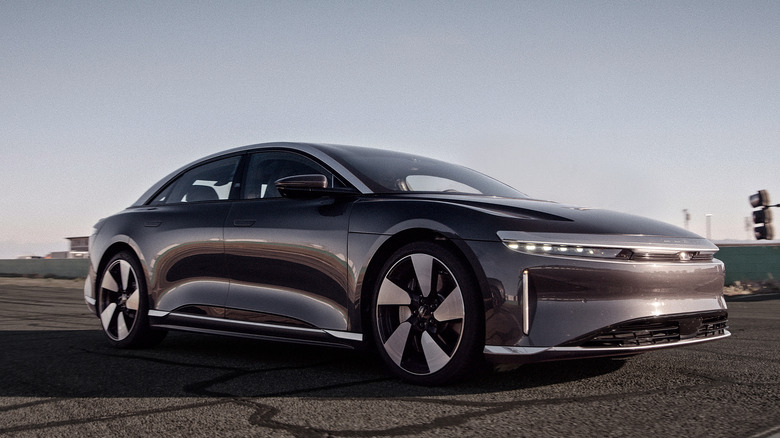This Lucid Air Deep-Dive Reveals Electric Cars' Big Advantage
Lucid CEO and Chief Technology Officer Peter Rawlinson has opened up about how his company achieved "class-leading" interior space in its Air range of electric vehicles. Speaking on the company's Youtube channel, Rawlinson explained how the goal was to create a vehicle that was "smaller on the outside, and larger on the inside" than a regular, gas-powered car.
Standard cars are designed to incorporate an engine and transmission housing, which forces the driver's position backward. Electric vehicles, like the Lucid Air, don't have this issue — so Rawlinson and his team aimed to get the position of the driver's foot as close as possible to the front wheels. When combined with Lucid's "integrated drive unit," something Rawlinson said was designed to be "crazy smaller than anyone else had ever done before," engineers are able to shift the driver further forward while reducing the overall length of the vehicle. Despite fitting the motor, inverter, and transmission stack into a package small enough to fit in a flight bag, each integrated drive unit still produces a total of 670 horsepower.
The car's battery pack is also designed to provide maximum range while also providing maximum interior space. Using a demonstration model, Rawlinson showed how the battery layout was "truly sculpted around the Air's occupants." Elements of the batteries are double stacked in a "tunnel" that runs through the center of the vehicle and are also doubled up underneath the rear occupants' legs. Potential buyers can also choose between a 400-mile range model, which includes extra room in the back and provides "exceptional seat ergonomics," or a 500-mile range model with extra batteries built into the rear footwells.
Safety was also a consideration when designing the Air
Rawlinson also spoke about the safety aspects involved in maximizing the interior space — such as the relationship between the car's crumple zone and the rigid cabin, which he referred to as the "safety zone." The Lucid CEO singled out the meeting point behind the two zones and highlighted how his team had created a reinforced, impact-absorbing structure close to the two front wheels. Rawlinson also pointed out how the car's "Wunderbox" doubles as a secondary bulkhead, further adding structure to this vital area.
Although the vehicle's overall length was reduced, engineers worked to maximize the Air's wheelbase, maximizing interior space with it. Other factors were considered with the wheelbase because even though more distance between the front and rear wheels provides stability, it also makes a car less agile. Rawlinson said keeping the vehicle agile was an important part of Lucid's mission to create a "driver's focus machine," and this was taken into account when deciding on the car's wheelbase. Rawlinson claims that the spacious Air was designed for the "98th percentile of vehicle occupants" and will accommodate all but 2% of the population comfortably.
